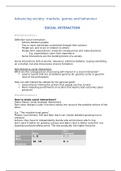Advancing society: markets, games and behaviour
SOCIAL INTERACTION
Interactive lecture 1
Definition social interaction
- Actions between people
- Two or more individuals (connected through their actions)
- People act, and re-act in relation to others
- People form expectations, evaluate consequences and make decisions
o E.g. expectations come from experience
- Social interactions are the building blocks of a society
Social interactions with economic relevance: politician debates, buying something
on a market, but also the process of price formation
Self-interest & social interactions
What are the consequences of pursuing self-interest in a social interaction?
Lead to results that are considered good by all, good by some or good for
none of the participants
How can self-interest be utilized for the general good?
Governments limiting the actions that people are free to take
Peers imposing punishments on actions that lead to bad outcomes (peer
pressure)
Interactive lecture 2
How to study social interactions?
Game theory: study strategic interactions
Each actor designs a plan of actions taking into account the possible actions of the
other
E.g. “The invisible hand game”
Players: two farmers, Anil and Bala (each can choose between growing rice or
cassava)
Actions: they have to independently decide who will produce which crop
Anil’s land is better for growing cassava and Bala’s land is better suited for rice
Quantity produced affects price. The less produced, the higher the price
Bala
Rice Cassava
Anil 6,8 7,7
Rice
10 , 10 8,6
Cassava
,In this case, no player has any incentive to change their strategy
Even though people act out of self-interest, the invisible hand can still make sure
that there is a socially acceptable outcome
If all people are altruistic, there would be no prisoner dilemma (e.g. the pull/push
experiment; altruistic people will always choose push because this result in the
highest total outcome)
More common: reciprocal altruism, which means that you will only cooperate if the
other person also cooperates
In general, believes and expectations play a big role and they can change the
strategies in the game. But, it is hard to recognize if people are altruistic and in what
way
Public goods game
50% are conditional cooperators (tit-for-tat)
30% are free-riders (never contribute to the common good)
15% are altruists (always contribute)
5% cannot be classified
Free riding is contagious
The economy – social interaction
Introduction
o Game theory is a way of understanding how people interact based on the
constraints that limit their actions, their motives, and their beliefs about what
others will do.
o In most interactions there is some conflict of interest between people, but
also some opportunity for mutual gain.
o The pursuit of self-interest can sometimes lead to results that are considered
good by all participants, or outcomes that none of the participants would
prefer.
o Self-interest can be harnessed for the general good in markets, by
governments limiting the actions that people are free to take, and by one’s
peers imposing punishments on actions that lead to bad outcomes.
4.1 Social interactions: Game theory
Strategic interaction: when people are engaged in social action and are aware of the
ways that their actions affect others, and vice versa
Strategy: an action that a person may take when that person is aware of the mutual
dependence of the results for herself and for others. The outcomes depend not only
on that person’s actions, but also on the actions of others
4.2 Equilibrium in the invisible hand game
, Best response (in game theory): the strategy that will give a player the highest
payoff, given the strategies that the other players select
Dominant strategy equilibrium: an outcome of a game in which every player plays
their dominant strategy
COOPERATION
Interactive lecture 1
Push or pull game
Push – increases your match’s payoff by 8
Pull – increases your own payoff by 6
Other player
Pull Push
You 6,6 14, 0
Pull
0, 14 8,8
Push
Pull is a dominant strategy, but (push, push) is a better outcome for both players
individually rational behavior can lead to bad outcomes (pareto-dominated by other
outcomes)
Push or pull – altruism
Player 1 derives positive utility from the monetary outcome to player 2
u1=π 1 + π 2
Altruism
If all people are altruistic, there is no prisoner’s dilemma
- Everyone takes full account of each other’s interest, and all externalities are
internalized
However, very few people are unconditionally altruistic
More common: reciprocal altruism:
- I would like to cooperate if (and only if) you cooperate
- Also: conditional cooperation





